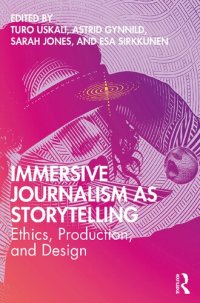
Ebook: Immersive Journalism as Storytelling; Ethics, Production, and Design
This book sets out cutting-edge new research and examines future prospects on 360-degree video, virtual reality (VR), and augmented reality (AR) in journalism, analyzing and discussing virtual world experiments from a range of perspectives.
Featuring contributions from a diverse range of scholars, Immersive Journalism as Storytelling highlights both the opportunities and the challenges presented by this form of storytelling. The book discusses how immersive journalism has the potential to reach new audiences, change the way stories are told, and provide more interactivity within the news industry. Aside from generating deeper emotional reactions and global perspectives, the book demonstrates how it can also diversify and upskill the news industry. Further contributions address the challenges, examining how immersive storytelling calls for reassessing issues of journalism ethics and truthfulness, transparency, privacy, manipulation, and surveillance, and questioning what it means to cover reality when a story is told in virtual reality. Chapters are grounded in empirical data such as content analyses and expert interviews alongside insightful case studies that discuss Euronews, Nonny de la Peña’s Project Syria, and The New York Times’ VR application NYTVR.
This book is written for journalism teachers, educators, and students as well as scholars, politicians, lawmakers, and citizens with an interest in emerging technologies for media practice.
Featuring contributions from a diverse range of scholars, Immersive Journalism as Storytelling highlights both the opportunities and the challenges presented by this form of storytelling. The book discusses how immersive journalism has the potential to reach new audiences, change the way stories are told, and provide more interactivity within the news industry. Aside from generating deeper emotional reactions and global perspectives, the book demonstrates how it can also diversify and upskill the news industry. Further contributions address the challenges, examining how immersive storytelling calls for reassessing issues of journalism ethics and truthfulness, transparency, privacy, manipulation, and surveillance, and questioning what it means to cover reality when a story is told in virtual reality. Chapters are grounded in empirical data such as content analyses and expert interviews alongside insightful case studies that discuss Euronews, Nonny de la Peña’s Project Syria, and The New York Times’ VR application NYTVR.
This book is written for journalism teachers, educators, and students as well as scholars, politicians, lawmakers, and citizens with an interest in emerging technologies for media practice.
Download the book Immersive Journalism as Storytelling; Ethics, Production, and Design for free or read online
Continue reading on any device:

Last viewed books
Related books
{related-news}
Comments (0)